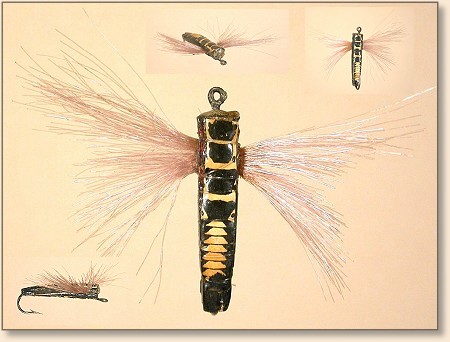Many of those who lived in the Rocky Mountain states
are familar at least with the name Bunyan Bug, 'tho
most had not actually seen one until the "movie,"
A River Runs Through It hit the movie theaters.
Like many urban ledgends, there is some truth to at least
parts of all of them. The fly supposedly was suggested
by Norman Maclean (who wrote the book) and created by
Norman Edward Lee Means, both men of Missoula, Montana.
Or it could have been vise-versa. At any rate most will
agree the Bunyan Bug was designed to imitate the Salmon
Fly, a very popular hatch. Bigger was better.
The first Bunyan Bugs appeared in about 1929, and were
all hand painted. Later, production models were made
with a decal (fine tissue) which was lacquered in place
making the paper disappear, leaving just the image.
According to George Grant in his book Montana Trout
Flies, the materials are as follow:
"Hook: Size 4, heavy-wire, shank length about 1 1/4",
also made with size 2 hook.
Cork Body: Just about same length as hook shank.
Generally round but slightly flattened on both sides and
bottom.
Color: Stained or painted deep orange. Segmented
markings can be applied with permanent ink pens both top
and bottom. Use black or dark brown ink.
Wings: Hair from horse mane, blonde or light sandy,
inserted into front end of body so that wings will lie flat
and spent.
Tying note: Body with wings cemented in slit, should be
slit (not very deep) lengthwise and placed on top of hook so
that almost all of the cork body is on top.
A strong tying thread, attached to the hook shank prior to
positioning the cork body, will now be wound firmly at segment
marking to firmly seat the body on the shank.
Use of strong adhesives in seating both wings and body will
assist in keeping all parts in proper position.
Tying thread should be fastened off ahead of the wings with
a whip finish. Coat entire body with clear varnish."
In a Fly Tyer article, (vol. 5, issue 2, August 1982,
page 36 written by Bob Newell), it was mentioned
that other patterns were also available, grasshopper, stonefly,
drakes, horse fly, bubble bee, ants and caddis, a total of
15 different patterns.
Start saving your wine corks...ought to work just fine.
~ DLB
Credits: The quoted text from Montana Trout
Flies, by George Grant.
|

